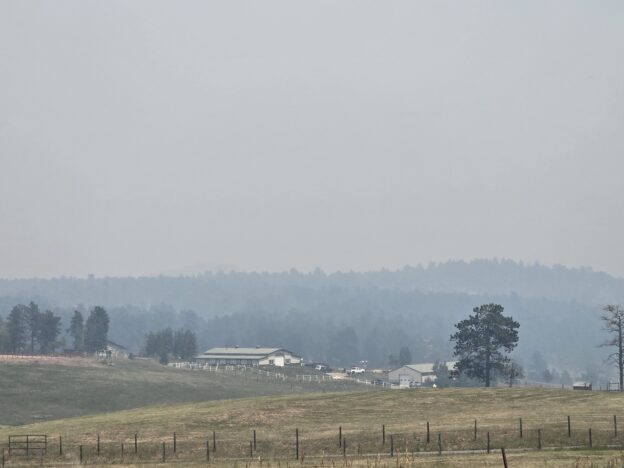As wildfires become increasingly common and intense, knowing how to protect yourself and your family from their effects is crucial. Whether you live in a wildfire-prone area or are facing smoke from a distant blaze, taking proactive steps can make a significant difference in your safety and health. Here’s some suggestions on how to stay safe when wildfires and smoke are in your area.
Understand the Risks
- Direct threat: Wildfires can rapidly spread and pose a direct threat to homes and lives.
- Air Quality: Wildfires produce significant amounts of smoke and particulate matter that can severely impact air quality.
- Health Effects from Smoke: Smoke from wildfires contains harmful pollutants such as carbon monoxide, volatile organic compounds, and fine particulate matter that can irritate the eyes, throat, and lungs.
Prepare Your Home
- Create a Defensible Space: Clear Vegetation to create firebreaks. Remove dead plants, leaves, and other flammable materials from around your home. Maintain a defensible space of at least 30 feet.
- Fire-Resistant Materials: Use fire-resistant materials for roofing, siding, and decks to reduce the risk of ignition.
Prepare an Emergency Kit
- Essentials: Include items such as non-perishable food, water, medications, a flashlight, batteries, and a battery-powered radio.
- Important Documents: Keep copies of important documents, including identification, insurance papers, and medical records in a safe place such as a fire safe or off-site.
Plan for Evacuation
- Escape Routes: Know your evacuation routes and have multiple plans in place in case roads are blocked.
- Family Plan: Establish a communication plan with family members and designate a meeting spot.
- Pets: Have pet carriers readily available for a quick evacuation.
- Valuables: People and animals are always the priority, but if you have notice of pre-evacuation, having a list of your most important items to grab is a good idea.
Stay Informed
- Monitor Local News and Emergency Alerts: Sign up for emergency alerts from local authorities and use apps that provide real-time updates on wildfire status and air quality.
For Jefferson County residents: https://www.jeffco.us/473/Emergency-Notifications
For Clear Creek County residents: https://www.clearcreekcounty.us/781/Emergency-Notification-System
For Park County residents: https://www.parkcountyco.gov/97/CodeRED
Apps:
https://www.frontlinewildfire.com/live-fire-map-track-wildfires-near-you
- Monitor Weather Conditions: Keep track of weather conditions that may affect wildfire behavior, such as wind speed and direction.
- Check Air Quality: Air Quality Index (AQI): Use online resources or apps to monitor the AQI in your area. The AQI provides information on the safety of outdoor air and can help you make informed decisions. https://www.airnow.gov/airnow-mobile-app
Protect Yourself from Smoke
- Stay Indoors: Limit outdoor activities
- Reduce Physical Activity: Especially reduce strenuous exercise, as it can increase your exposure to harmful pollutants.
- Prioritize rest and hydration to help your body cope with smoke exposure.
- Use High Quality Air Purifiers: Use air purifiers with HEPA filters to reduce indoor air pollution.
- Close Windows and Doors: Keep windows and doors closed to prevent smoke from entering your home.
- Create a Clean Room: Designate a room with the best air quality in your home, preferably with an air purifier and limited windows, to serve as a refuge from smoky air.
Protect Your Health by Avoiding Exposure
- Stay Inside as much as possible.
- Masks: If you must go outside, consider wearing an N95 respirator mask to filter out fine particles. Note that standard masks or cloth masks are not effective for filtering out smoke particles.
- Health Precautions: Those with pre-existing health conditions such as asthma or heart disease should take extra precautions and consult their healthcare provider.
- Watch for Symptoms: Be aware of symptoms such as coughing, wheezing, shortness of breath, or irritated eyes. Seek medical attention if symptoms persist or worsen.
After the Smoke Clears
- Ventilate Your Home: Once the air quality improves, ventilate your home by opening windows and using fans to remove lingering smoke particles.
- Clean Up Dust and Debris: Clean surfaces in your home that may have accumulated dust or smoke residue. Don’t forget surfaces such as walls and ceilings where particles accumulate. And of course, your windows, so you can enjoy your view again.
Stay Informed on Recovery and Community Resources
- Stay updated on community recovery efforts and resources available for those affected by the wildfires.
- Consider volunteering or contributing to recovery efforts if you are able.
Conclusion
Wildfires and their accompanying smoke pose significant risks, but taking preventive measures and staying informed can help you navigate these challenges safely. By preparing your home, monitoring conditions, protecting your health, and knowing how to respond in the aftermath, you can mitigate the impact of wildfires and ensure the safety of yourself and your loved ones. Remember, staying vigilant and proactive is key to managing the risks associated with wildfires and smoke.
